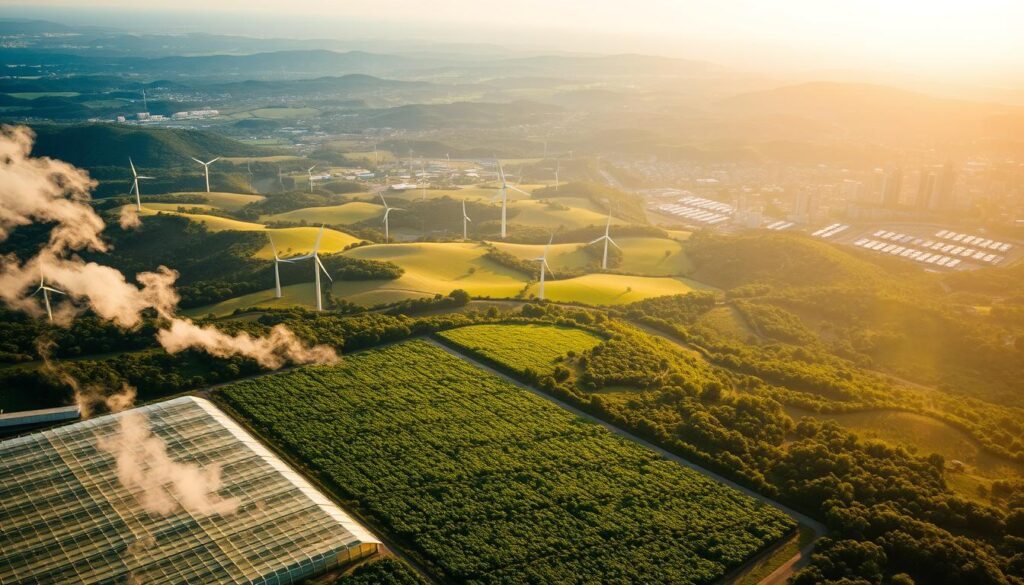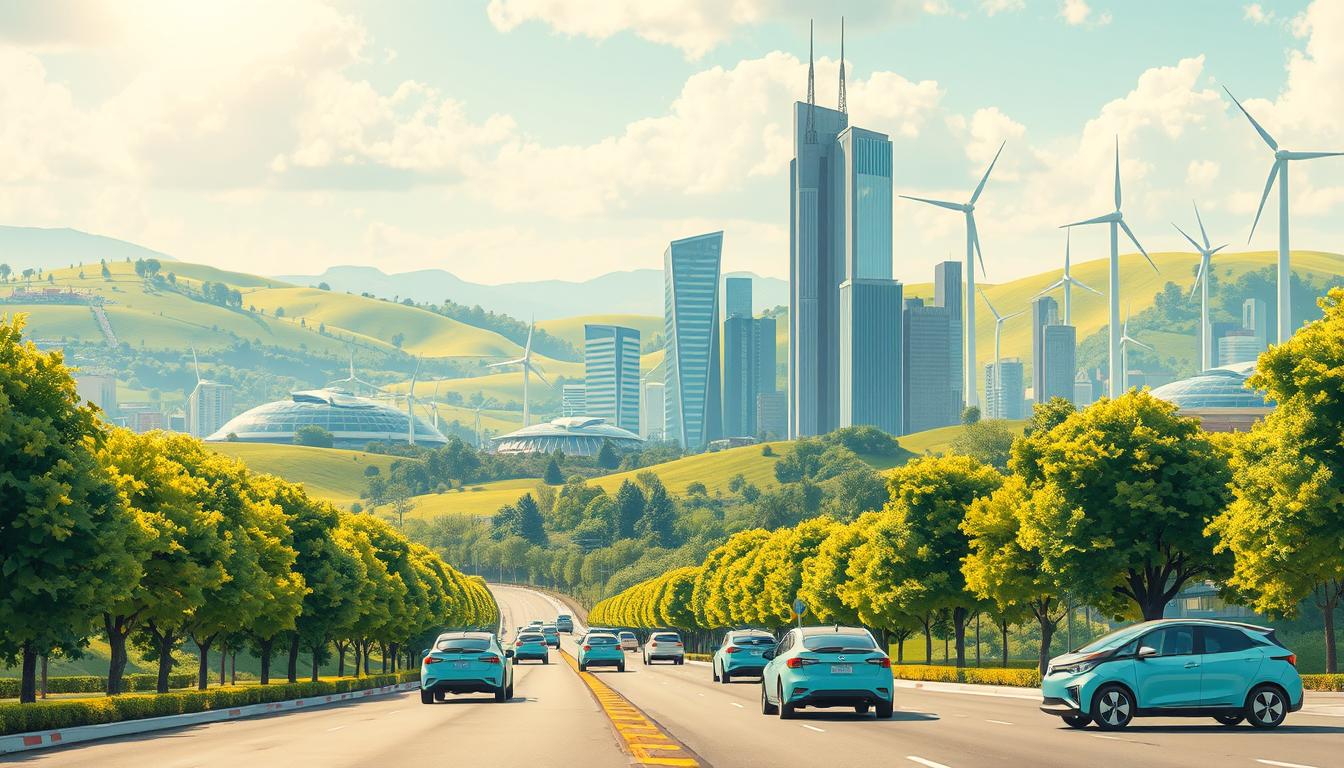The world is at a crossroads, facing unprecedented challenges like climate change, biodiversity loss, and pollution. Green technology has emerged as a critical response to these issues, offering innovative solutions to create a more sustainable future. With global investments in renewable energy surpassing $3 trillion in 2024, the sector is growing rapidly, proving its potential to reshape industries.
In the United States, 71% of new energy capacity in 2024 comes from wind and solar power. This shift highlights the mainstream adoption of clean energy sources. The IPCC’s recommendation to limit global warming to 1.5°C above pre-industrial levels further emphasizes the urgency of adopting these technologies.
From energy to transportation and waste management, green technology is driving practical applications across sectors. It’s not just about sustainability—it’s about creating economic opportunities and jobs while addressing pressing environmental concerns. This article explores the historical context, emerging innovations, and ethical considerations shaping this transformative field.
Key Takeaways
- Green technology addresses climate change, biodiversity loss, and pollution.
- Global renewable energy investments exceeded $3 trillion in 2024.
- 71% of new U.S. energy capacity comes from wind and solar power.
- The IPCC recommends limiting global warming to 1.5°C.
- Green technology drives job creation and economic growth.
What Is Green Technology?
The rise of sustainable practices marks a turning point in global development. Green technology combines science and innovation to protect the environment and reduce harm. It’s a broad term that includes everything from renewable energy to waste management.
Definition and Core Principles
Green technology focuses on minimizing environmental impact while promoting sustainability. It differs from clean tech, which improves process efficiency, and climate tech, which targets greenhouse gas reduction. Together, these fields aim to create a healthier planet.
Key principles include reducing reliance on fossil fuels, conserving resources, and lowering emissions. This approach not only addresses climate change but also supports economic growth and job creation.
Historical Evolution of Green Tech
The roots of green technology trace back to the 1930s. The Dust Bowl crisis led to the Soil Conservation Act of 1935, one of the first efforts to protect natural resources. During WWII, over 400,000 volunteers pioneered recycling programs, laying the foundation for today’s circular economy.
In 1970, the establishment of the EPA formalized pollution standards, marking a major step forward. Rachel Carson’s warnings about pesticides also played a pivotal role in raising awareness. Today, frameworks like the EU Taxonomy guide modern green tech development, ensuring it aligns with global sustainability goals.
From reactive solutions to proactive regeneration, green technology continues to evolve. It’s a testament to humanity’s ability to innovate for a better future.
Key Types of Green Technology

Innovative solutions are reshaping industries to meet environmental challenges. From energy to transportation, these advancements are driving practical applications across sectors. Let’s explore the key types of technologies making a difference today.
Renewable Energy Solutions
Renewable energy sources like solar panels and wind power are leading the charge. In 2024, the U.S. added 37GW of solar capacity, making it cheaper than fossil fuels in most countries. Wind power is also growing, with projections suggesting it could supply 35% of U.S. electricity by 2050.
Hydroelectric power offers a low-carbon alternative but comes with trade-offs. While it reduces emissions, it can impact local ecosystems. Balancing these factors is crucial for sustainable development.
Sustainable Transportation
Electric vehicles (EVs) are transforming the transportation sector. They significantly reduce carbon emissions, but challenges like lithium mining for EV batteries remain. Despite this, the benefits of cleaner air and reduced fuel dependency outweigh the drawbacks.
Hydrogen fuel cell transportation is another promising solution. It offers a cleaner alternative to traditional biofuels, paving the way for a more sustainable future.
Waste Management and Recycling
Advanced waste management systems are making a significant impact. For example, San Francisco’s program diverts 80% of waste from landfills through advanced sorting. Waste-to-energy systems are also gaining traction, converting waste into resources and preventing 4,000 tons of CO2 annually.
The circular economy is another key focus. Companies are upcycling manufacturing waste, reducing pollution, and conserving resources.
Energy Efficiency Innovations
Energy-efficient technologies are reducing power consumption across industries. Smart grids in Texas have cut peak demand by 5%, showcasing the potential of these systems. ENERGY STAR-certified appliances also play a role, reducing energy use by 10-50%.
IBM’s smart irrigation system is another example. It reduces water use by 30%, demonstrating how innovative solutions can conserve vital resources. Learn more about how these technologies are shaping a sustainable.
The Environmental Impact of Green Technology

The fight against environmental degradation is reshaping industries worldwide. From reducing greenhouse gas emissions to conserving natural resources, sustainable innovations are making a significant impact. However, these advancements also come with unintended consequences that need careful consideration.
Reducing Greenhouse Gas Emissions
Transportation is a major contributor to greenhouse gas emissions, accounting for 31% of the U.S. total. Electric vehicles (EVs) are a promising solution, but the extraction of lithium for EV batteries raises concerns. For example, rainforest lithium mining can harm ecosystems, creating a paradox in sustainable practices.
Life cycle assessments reveal that solar panel production emits less carbon dioxide than coal plants. However, the manufacturing process still requires significant energy. Balancing immediate emission cuts with long-term resource conservation is essential for true sustainability.
Innovations like carbon capture projects aim to reduce emissions further. While Chevron’s efforts have faced challenges, direct air capture (DAC) projects show promise. These technologies could play a crucial role in mitigating climate change.
Conserving Natural Resources
Water-saving technologies are transforming agriculture. Vertical farming uses 70% less water than traditional methods, addressing both resource conservation and food security. Similarly, smart irrigation systems reduce water waste by 30%, showcasing the potential of innovative solutions.
Regenerative agriculture is another key focus. It improves soil health while sequestering carbon dioxide, offering dual benefits. This approach not only combats climate change but also enhances agricultural productivity.
Consumer trends also reflect a shift toward sustainability. McKinsey reports that 60% of consumers are willing to pay a premium for eco-friendly packaging. Products with ESG claims see 28% higher sales growth compared to non-ESG alternatives, highlighting the market’s growing demand for sustainable options.
For more insights on how these advancements are shaping the future, visit this detailed analysis.
Benefits of Adopting Green Technology
Adopting sustainable practices offers both environmental and economic advantages. Companies are increasingly recognizing the value of integrating eco-friendly solutions into their operations. From reducing costs to enhancing brand loyalty, the benefits are clear.
The $1.2 trillion U.S. Infrastructure Act is a game-changer. It allocates significant funds for clean grid upgrades and school bus electrification. These initiatives not only reduce emissions but also create jobs, driving economic growth.
Job growth in the renewable energy sector is outpacing fossil fuels. In 2024, solar jobs outnumbered coal jobs by a 10:1 ratio. This shift highlights the potential for sustainable practices to reshape the industry and provide long-term employment opportunities.
Patagonia’s regenerative supply chain is a prime example. By focusing on sustainable production, the company has seen increased profits while reducing its environmental footprint. This approach demonstrates how businesses can thrive by prioritizing eco-conscious practices.
- Energy-efficient building retrofits offer a return on investment (ROI) within 5-7 years.
- Reduced particulate emissions save $3 billion annually in healthcare costs.
- Brands with strong sustainability reporting see a 28% boost in customer loyalty.
The Department of Energy (DOE) is supporting industrial decarbonization through grants. These projects aim to reduce emissions while maintaining production efficiency. Additionally, climate-resilient businesses benefit from lower insurance premiums, further incentivizing sustainable practices.
Walmart’s Project Gigaton is another success story. By working with suppliers to reduce emissions, the company has made significant progress toward its sustainability goals. Similarly, Microsoft’s roadmap to become carbon-negative by 2030 sets a benchmark for other companies to follow.
These examples show that adopting sustainable solutions is not just good for the planet—it’s good for business. By addressing environmental challenges, companies can create a healthier world while securing their future in a competitive market.
Challenges and Obstacles in Green Tech Adoption
Adopting sustainable innovations faces significant hurdles despite their potential. One major issue is transformer shortages, which delay clean grid expansion. These bottlenecks slow down renewable energy projects, making it harder to transition from fossil fuels.
Plastic recycling also presents challenges. Globally, only 9% of plastics are recycled due to technical and financial gaps. This low rate highlights the need for better technologies and systems to manage waste effectively.
Biofuel production raises another concern. Corn ethanol, for example, competes with food crops, creating a food vs. fuel conflict. This issue underscores the need for sustainable alternatives that don’t compromise food security.
Carbon capture projects face limitations too. Current capacities of 4,000 tons per year fall short of the gigaton needs required to combat pollution effectively. Scaling these technologies remains a critical challenge.
Workforce retraining is another obstacle. Coal communities struggle to adapt to new industry demands, requiring significant investment in education and job placement programs.
Rare earth mineral dependencies in wind turbine manufacturing add to the issues. These materials are essential but often sourced unsustainably, creating environmental and ethical concerns.
Electric vehicles (EVs) face upfront cost barriers. While long-term maintenance savings are significant, initial prices deter many consumers. Policy inconsistencies in federal and state clean energy incentives further complicate adoption.
Smart grid systems, though promising, suffer from inefficiencies. Some systems experience up to 40% power loss, reducing their overall effectiveness.
Lithium-ion batteries, while crucial for EVs, pose fire risks. These safety concerns contrast with the established safety records of petroleum-based fuels, creating a need for safer alternatives.
| Challenge | Potential Solution |
|---|---|
| Transformer shortages | Increase production capacity and streamline supply chains |
| Plastic recycling gaps | Invest in advanced sorting and recycling technologies |
| Biofuel competition | Develop non-food crop biofuels |
| Carbon capture limitations | Scale up direct air capture projects |
| Workforce retraining | Expand education and job placement programs |
| Rare earth dependencies | Explore alternative materials and sustainable sourcing |
| EV upfront costs | Offer subsidies and incentives for EV purchases |
| Policy inconsistencies | Harmonize federal and state clean energy policies |
| Smart grid inefficiencies | Improve grid infrastructure and technology |
| Lithium-ion fire risks | Develop safer battery technologies |
The Future of Green Technology
The future of sustainable innovation is being shaped by groundbreaking advancements and regenerative practices. From direct air capture to green hydrogen, these technologies are transforming industries and addressing climate change head-on. The shift from mitigation to regeneration is creating a new era of environmental progress.
Emerging Trends and Innovations
Direct Air Capture (DAC) is one of the most promising solutions for reducing carbon emissions. The Department of Energy aims to scale DAC to capture 1 million tons of CO2 annually by 2025. Current prototypes are already showing significant potential, offering a scalable way to combat climate change.
Green hydrogen is another game-changer. With a projected market value of $160 billion by 2030, it’s set to revolutionize industries like steel and chemical production. Unlike traditional hydrogen, green hydrogen is produced using renewable energy sources, making it a cleaner alternative.
Mycelium-based packaging is replacing petroleum plastics, offering a biodegradable and sustainable option. Companies are also exploring energy-positive buildings that generate surplus power, reducing reliance on traditional grids.
The Path to Regenerative Business Models
Regenerative agriculture is gaining traction as a way to sequester carbon and improve soil health. It could potentially offset 10% of global emissions, making it a key player in the fight against climate change. Ocean farming is another innovative approach, enhancing biodiversity while capturing carbon.
Interface Flooring has set a benchmark with its carbon-negative manufacturing process. By using recycled materials and renewable energy, the company is proving that sustainability and profitability can go hand in hand.
Patagonia’s self-imposed Earth tax is another example of a regenerative business model. The company funds conservation projects through its profits, demonstrating a commitment to giving back to the planet.
| Innovation | Impact |
|---|---|
| Direct Air Capture | Targets 1M tons of CO2/year by 2025 |
| Green Hydrogen | Projected $160B market by 2030 |
| Mycelium Packaging | Replaces petroleum-based plastics |
| Energy-Positive Buildings | Generate surplus power |
| Regenerative Agriculture | Could sequester 10% of global emissions |
| Ocean Farming | Enhances biodiversity and carbon capture |
| Carbon-Negative Manufacturing | Interface Flooring’s sustainable model |
| Earth Tax | Patagonia’s funding for conservation |
AI-optimized smart grids are balancing decentralized renewable energy sources, ensuring efficient distribution. Meanwhile, fusion energy holds promise for post-2030 commercialization, offering a virtually limitless power source.
For more insights on how renewable energy technologies are shaping the future, explore this detailed analysis.
Conclusion
The clock is ticking for decisive action to combat climate change, with the IPCC’s 2030 deadline looming. To meet the 1.5°C threshold, emissions must be cut by 45% within this decade. Green technology offers the solutions needed to achieve this goal, from scaling renewable energy to advancing waste reduction strategies.
Businesses play a critical role in this transition. Conducting life cycle assessments, implementing ESG reporting, and auditing supply chains are essential steps. Individuals can contribute too, through home retrofits, EV adoption, and advocating for stronger policies.
The shift from linear to circular economic models is key to reducing waste and conserving resources. Supporting research in fusion energy and perovskite solar commercialization will drive future innovations. Public-private partnerships can modernize grids and accelerate progress.
Together, we can build a world powered by 100% renewables and zero waste. The time to act is now—our future depends on it.
FAQ
What is green technology?
Green technology refers to innovations designed to reduce environmental harm. It focuses on creating sustainable solutions that minimize pollution and conserve natural resources.
How does renewable energy differ from fossil fuels?
Renewable energy sources like solar and wind power are replenished naturally. Fossil fuels, such as coal and oil, are finite and contribute significantly to greenhouse gas emissions.
What are the benefits of sustainable transportation?
Sustainable transportation, including electric vehicles, reduces air pollution and dependence on fossil fuels. It also helps lower carbon emissions, contributing to a healthier environment.
How does waste management technology help the environment?
Advanced waste management systems improve recycling rates and reduce landfill use. This minimizes pollution and conserves valuable materials, supporting a circular economy.
What role does energy efficiency play in green tech?
Energy efficiency innovations reduce power consumption and lower utility costs. They also decrease the demand for energy production, which often relies on harmful fossil fuels.
What challenges hinder the adoption of green tech?
High initial costs, lack of infrastructure, and resistance to change are common obstacles. Addressing these issues requires investment, education, and supportive policies.
What are emerging trends in green technology?
Innovations like carbon capture, regenerative agriculture, and smart grids are gaining traction. These advancements aim to create a more sustainable and resilient future.
How does green tech impact climate change?
By reducing greenhouse gas emissions and promoting cleaner energy, green tech plays a critical role in combating climate change. It helps stabilize the atmosphere and protect ecosystems.
